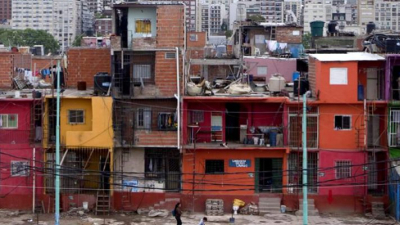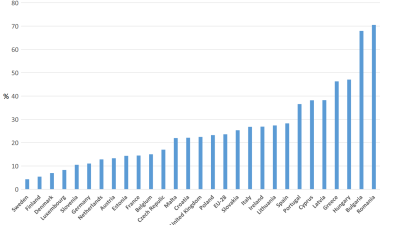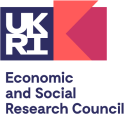Many poverty measurements use household income, adjusted for household size (see equivalence scales below), to find out who is in poverty. A level is set and those who fall below this are seen as being ‘in poverty’ and those above it are not.
The UK government, the European Union and many other countries use 60 per cent of median household income as the poverty ‘threshold’. Median income is the middle point in the income range, with equal numbers of households on incomes above and below that point. The 60 per cent level is chosen as an indicator of the income at which those below are likely to be suffering hardship. As such, it is a proxy measure of poverty and, without validation from direct measures of people’s living standards, is essentially arbitrary. The threshold’s importance is that it does show how the poorest members of society are doing in relation to others, it can be tracked over time, and allows comparisons between different countries.
In the past, 50 per cent of mean household income has been used as a poverty threshold. Mean (or average) income is the sum of all incomes divided by the number of incomes. Median income is now generally chosen in preference to mean income, as giving money to those on the lowest incomes will not in itself raise the median threshold but will raise the mean threshold. Raising the incomes of the deciles below the 60 per cent median income threshold does not alter the position of that threshold until these people have more income than those in the middle. The threshold changes only when the incomes of those on middle incomes change. By contrast, raising the incomes of those at the bottom will raise the position of the 60 per cent mean threshold, moving it further upwards along the range as the incomes of those on the lowest incomes increases. This means that while it is possible, in principle, to raise everyone above either 60 per cent of median or mean income, it requires less overall redistribution of income to meet the 60 per cent of median income target.
It does, however, have disadvantages. If the median income drops (as it did in the UK between 2010/11 and 2012/13 and between 2016/17 and 2018/19), the income threshold drops so the official numbers in poverty will drop even if the incomes of the poorest do not change. It also means that if the incomes of those in the higher income groups rises faster than the rest, it will not affect the median threshold (though it will raise the mean threshold). Using a percentage of the median as the poverty threshold means that the rich can get richer without having any impact on poverty measurement.
Misunderstanding the median threshold
The Coalition government of 2010-2015 wanted to to downgrade this official 60 per cent of median income measure of poverty, arguing that it is impossible to meet these median-based targets (see Redefining poverty). For example, Frank Field, appointed by the Coalition government to head an independent review into poverty (see Field Review) has argued:
Any candidate sitting GCSE maths should be able to explain that raising everybody above a set percentage of the median income is rather like asking a cat to chase its own tail. As families are raised above the target level of income, the median point itself rises. Not surprisingly, therefore, no country in the free world has managed to achieve this objective.
This is simply wrong. Taking a percentage of median income as the threshold means that giving money to those on the lowest incomes (those below the median income point) will not in itself raise the threshold; this makes it possible, in principle, to lift households above the 60 per cent threshold without affecting the median point.
You can reach the target of lifting all the poor above 60 per cent of median income without raising the target income per week simply by raising the incomes of the poorest without raising the incomes of those in the middle. The effect of this is to increase the total amount of income across all deciles (and hence mean income levels) but would not affect the median point.
You can also raise everyone above a set percentage of mean income without 'chasing your tail'. Though raising the incomes of those on the lowest incomes would raise the mean income level, decreasing the incomes of those on the highest incomes, simultaneously, would decrease it and so you could keep the mean threshold at the same level. The effect of this is to redistribute income from the richest groups in society to the poorest. The spread of incomes across the whole income range is now smaller; in other words there is greater equality.
In both these cases the spread of income across the bottom three deciles would be compacted. You could find other solutions that allowed for more differentiation at the bottom by redistributing more income from the top.
Equivalence scales
When using income to measure poverty, other decisions have to be made on whose income is being compared, what you count as income and how you compare between different people in different circumstances.
Poverty measures use net income – that is, total income minus direct taxes (income tax, national insurance and council tax) and plus the value of any social security benefits received. This is the income that people have available to buy goods and services. Most poverty measures then take household income rather than individual income and adjust the total net disposable income to reflect household composition and size – to make each income ‘equivalent’. This is called net household equivalised income.
Official government statistics use what’s known as the ‘modified OECD’ (Organisation for Economic Co-operation and Development) equivalence scale, in which an adult couple with no dependent children is taken as the benchmark with the equivalence scale of one. The equivalence of different types of household can be calculated by adding together the weight of the various household members as shown below.
Modified OECD Equivalence Scale
|
Head
|
0.67
|
|
Subsequent adult
|
0.33
|
|
Each child aged 0-13
|
0.20
|
|
Each child aged 14-18
|
0.33
|
To find out where any individual lies on the income distribution scale, you need to make a number of calculations based on the type of household they live in and the household income. If you are interested in where you lie, the Institute for Fiscal Studies provides a quick and easy calculator to do this.
Clearly, which equivalence scale is used and, in particular, what percentage is given to children in the scale can make a difference to how different types of household appear to fare. Many have argued that the current scales give insufficient weight to the costs of bringing up children and thereby produce lower estimates of poverty than a scale that more accurately reflects the costs of bringing up children.
More on this debate on equivalence scales can be found on pages 49 to 51 of ‘The concept and measurement of poverty’ in Poverty and Social Exclusion in Britain (Gordon, 2006) and in Chapter 5 of Bare Necessities: Poverty and Social Exclusion in Northern Ireland (Hillyard et al., 2003).
Back to top
Limitations
These income-based measures provide important information on the extent to which government targets are being met. But they have many limitations. They are only an indirect indicator of poverty; they do not measure need and deprivation. They do not take into account financial resources other than income, or other financial deductions such as debt. And they don’t take into account non-income-based resources, such as the level of service provision.
In particular, taking a threshold as simply a percentage of median or mean income is essentially arbitrary. It is possible to set an income threshold based on the level of income required to meet certain levels of need – but this first requires an examination of people’s living standards to establish what needs should be met and who falls below this standard. To do this, other ways of thinking about and measuring poverty need to be developed.
The consensual method for measuring poverty has developed a way to calculate a poverty threshold that combines both low living standards and low income. The minimum budget standards approach looks for ways to set a minimum acceptable standard of living and then at ways to calculate the budget needed to meet this standard.
Poverty trends
Data on the extent of poverty in the UK using various income threshold measures can be found on the Joseph Rowntree poverty site.
References
Gordon, D. (2006) ‘The concept and measurement of poverty’ in Poverty and Social Exclusion in Britain, Bristol, The Policy Press.
Hillyard P., Kelly, G., McLaughlin, E., Patsios, D. and Tomlinson, M. (2003) Bare Necessities: Poverty and Social Exclusion in Northern Ireland, Belfast, Democratic Dialogue.
Back to top
Last updated: 12 May, 2023



 PSE:UK is a major collaboration between the University of Bristol, Heriot-Watt University, The Open University, Queen's University Belfast, University of Glasgow and the University of York working with the National Centre for Social Research and the Northern Ireland Statistics and Research Agency. ESRC Grant RES-060-25-0052.
PSE:UK is a major collaboration between the University of Bristol, Heriot-Watt University, The Open University, Queen's University Belfast, University of Glasgow and the University of York working with the National Centre for Social Research and the Northern Ireland Statistics and Research Agency. ESRC Grant RES-060-25-0052.






